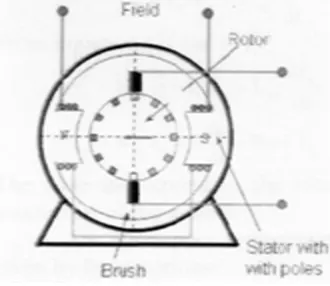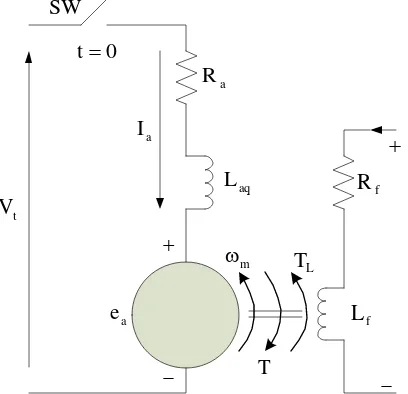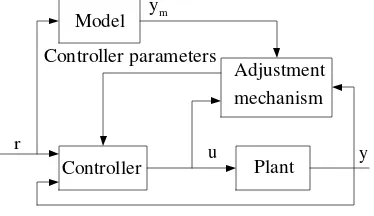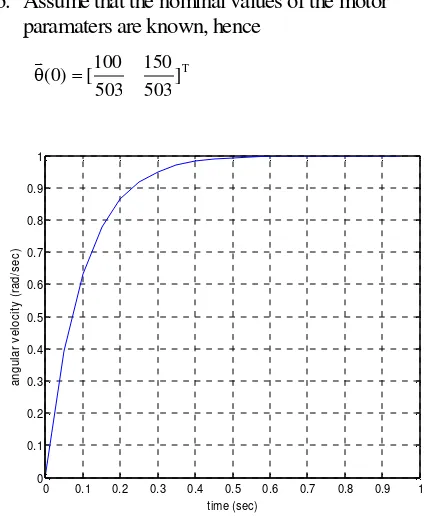Robust Model Reference Adaptive Control of Angular Velocity Control
Simulation of Brushed DC Motor
Sabat Anwari
Departmen of Electrotechnic ITENAS Bandung e-mail: [email protected]
Abstract
Electric motors play an important role in industry as well as our day-to-day life. They are used to generate electrical power in power plants and provide mechanical work in industries. They are also an indispensable part of our daily lives. Electric motors are very important pieces of equipment in our everyday lives. The brushed DC motor is considered to be basic electric motors. The aim of this paper is to introduce students to the modelling of brushed dc motor and to use computer simulation as a tool for conducting transient and control studies. Simulation can be very helpful in gaining insights to the dynamic behaviour and interactions that are often not readily apparent from reading theory. Next to having an actual system to experiment on, simulation is often chosen by engineers to study transient and control performance or to test conceptual designs. Presently, there are many control laws available to control the brushed dc motor. The control law of angular velocity depends on the motor parameters. The motor parameters are time varying, especially load torque, hence adaptive control is one of the best control law. In standard adaptive control, instability may be occur in the presence of unmodeled dynamics. Robust adaptive control is designed so the stability can be guaranteed.
Keywords: brushed dc motor, unmodeled dynamics, robust adaptive control, simulation.
Abstrak
Motor elektrik memegang sebuah peranan yang penting dalam industri, begitu juga dalam hidup kita hari per hari. Motor tersebut digunakan untuk membangkitkan daya elektrik dalam plant-plant daya besar dan menyediakan kerja mekanik dalam industri. motor tersebut juga sebuah bagian yang tidak terlepaskan dari kehidupan kita sehari-hari. Motor-motor elektrik merupakan bagian peralatan yang sangat penting dalam kehidupan setiap hari kita. Motor DC bersikat dipertimbangkan sebagai motor elektrik dasar. Tujuan paper ini adalah memperkenalkan pada siswa terhadap pemodelan motor dc bersikat dan menggunakan simulasi komputer sebagai sebuah alat untuk mempelajari kondisi peralihan dan kendali. Simulasi dapat sangat membantu dalam menambah pemahaman terhadap tingkah laku dinamik dan interaksi-interaksinya yang seringkali tidak nampak dalam teori yang dibaca. Untuk dilanjutkan pada sistem nyata dalam bentuk percobaan, simulasi sering dipilih oleh para insinyur untuk mempelajari kinerja peralihan dan kendali atau untuk mencoba rancangan-rancangan konseptual. Saat ini, ada beberapa hukum kendali yang tersedia untuk mengendalikan motor dc bersikat. Hukum kendali untuk kecepatan sudut tergantung pada parameter-parameter motor. Parameter motor tersebut bervariasi terhadap waktu, khususnya torka beban, sehingga kendali adaptif merupakan salah satu hukum kendali yang terbaik. Dalam kendali adapatif standar, ketidakstabilan mengkin terjadi dengan adanya dinamika yang tidak termodelkan. Kendali adaptif kokoh dirancang sedemikian sehingga kestabilan dapat dijamin.
Kata kunci: motor dc bersikat, dinamika yang tidak termodelkan, kendali adaptif kokoh, simulasi
Introduction
The brushed DC motor is widely used in many variable speed drives. Open-loop operation of the motor can be unsatisfactory in some industrial applications. If the drive requires constant-speed operation under changing load torque, closed-loop control is necessary. The dynamic response of the brushed dc motor angular velocity control depends on the designed control law.
Catatan: Diskusi untuk makalah ini diterima sebelum tanggal 1 Juni 2006. Diskusi yang layak muat akan diterbitkan pada Jurnal Teknik Elektro volume 6, nomor 2, September 2006.
distur-bances [6]. Robust adaptive control is proposed to guarantee the stability in the presence of uncer-taintay.
This paper proposes a high performance Robust Model Reference Adaptive Control (RMRAC) control law to control the brushed dc motor angular velocity. This method should be able to learn about parameters changes by processing the output of system and use appropriate gains to accommodate them so it avoids the need of the knowledge the mechanical parameters motor exactly and it does not require the identification of these parameters [1]. It is proposed the application of this technique on the mechanic part of the system.
The remainder of this paper is organized as follows. Section II introduces the model of brushed dc motor, section III presents the RMRAC structure, section IV presents simulation results, section V discussion. Finally, section VI presents conclusions of this paper.
Modelling
A theory is a general statement of principle abstrac-ted from observation. A model is a representation of a theory that can be used for control and prediction. For a model to be useful, it must be realistic and yet simple enough to understand and manipulate. These requirements are not easily fulfilled as realistic models are seldom simple and simple models are seldom realistic.
The scope of a model is defined by what is consi-dered relevant. Features or behaviour that is relevant must be included in the model and those that are not can be ignored. Modelling refers to the process of analysis and synthesis to arrive at a mathematical description that contains the relevant dynamic charac-teristics of the particular model [10].
Figure 1 Brushed DC Motor Cons-truction
The stator of the DC motor has poles, which are excited by DC current to produce magnetic fields. The rotor has a ring-shaped laminated iron-core with slots. Coils with several turns are placed in the slots. The distance between the two legs of the coil is about 180 degrees. The coils are connected in series. To keep the torque on a DC motor from reversing every time the coil moves through the plane perpendicular to the magnetic field, a split-ring device called a commutator is used to reverse the current at that point. The commutator shown in Figure 2 consists of insulated copper segments mounted in a cylinder. The electrical contacts to the rotating ring are called "brushes" since copper brush contacts were used in early motors. Modern motors normally use spring-loaded carbon contacts, but the historical name for the contacts has persisted. Two brushes are pressed to the commutator to permit current flow. The brushes are placed in the neutral zone (magnetic field is close to zero) to reduce arcing [8].
Figure 2 Concept of The Commutator
In any electric motor, operation is based on simple electromagnetism. A current carrying conductor generates a magnetic field which when placed in an external magnetic field, it will experience a force proportional to the current in the conductor and to the strength of the external magnetic field. The internal configuration of a DC motor is designed to harness the magnetic interaction between a current-carrying conductor and an external magnetic field to generate rotational motion.
To perform the simulation of a system, an appropriate model needs to be established. For this paper, the system contains a DC motor. Therefore, a model based on the motor specifications needs to be obtained.
aq
Figure 3 Schematic Diagram of a Brushed DC Motor
Applying a constant stator current and assuming magnetic linearity, the basic motor equations are
a
The term Bωrepresents the rotational loss torque of the system.
The state-space representation is given by the equations:
Du
The transfer function between angular velocity and voltage is
0
The transfer function between angular velocity and Load Torque is
0
In most DC motors, the rotor inductance and the value of B are small that can be neglected to lead to reduced order.
If
L
aq is neglected then Eq. (4) becomesThe current-voltage relationship for the left hand side of the equation can be written and manipulated to relate between voltage and angular velocity.
a
We adopt from Kiong Howe [7] for the nominal first order linear model of a motor is shown in (15).
2
The exact model and the nominal model can be related as
)
∆
is a multiplicative perturbation.Robust Model Reference Adaptive Control
Adaptive methods seek to use on-line observations, as well as a priori information, to improve the control of system over time in response to changes and unknowns in the system and environment [1]. Adaptive methods in control system posseses several advantages, e.g., fast response, good transient response, robustness of stability, insensitivity to the matching parameters variations and external disturbances. Model Reference Adaptive Control (MRAC) is one of adaptive model methods.
Model
Figure 4. Block Diagram of MRAC
In standard MRAC, the adaptive law is based on a plant model that is free of noise, disturbances, and unmodeled dynamics. An actual plant may be infinite dimensional, nonlinear, and its measured input and output may be corrupted by noise and external disturbances. The effect of the discrepancies between the plant and the actual plant on the stability and performance may not be known until it is implemented on the actual plant. In Robust Model Reference Adaptive Control (RMRAC), the adaptive law is based on a plant model with uncertainty.
Let us consider the plant
u function of the plant and
∆
m is a multiplicative perturbation. The control objective is to choose u such that all signals in the closed-loop plant arebounded and
y
tracks as close as possible the outputm
The model reference control law is given by
r
control objective for the plant model (20) exactly. Let us now implement the same control law on the actual plant (18). The closed-loop plant is given by
r
whose characteristic equation is
0
Because
m
is strictly proper with stable
poles, it follows from the Nyquist criterion that a sufficient condition for the closed-loop system to be stable is that
∆
m(
s
)
satisfiesFurthermore
Therefore, the smaller the term
better the stability margin and tracking performance will be.
If a and b are unknown then u is to be chosen so that the closed-loop plant is stable and
y
tracks as close as possible the outputy
m of the reference model. The control law based on modeled part of the plant obtained by neglecting∆
m is given bycontroller parameters, we write the control law as
r
and use (18) to obtain the closed loop-plant) the error equation
r
The ideal error equation is obtained by setting
0
Candidate for Liapunov function
Derivative of Liapunov function
)
Adaptation law
e
bounded disturbance in the error equation. Furthermore∆
m(
s
)
changes the transfer functionthat relates
e
to~
θ
1 ande
to~
θ
2 from and (42) may lead to instability when applied to (18) due to the presence of the disturbance term that appears in the error equation. One way to counterattact the effect of the disturbance introduced by∆
m(
s
)
≠
0
andr
≠
0
to modify (41) and (42)where σ is small positive constant.
) s ( Gm
) s ( G Σ u
Π +
Σ
+
2
θ
Π
γσ +
γ −
s
1
θ
Π Π
e −
r
m
y
y
+
γσ +
γ −
s
Figure 5. Block Diagram of The Designed RMRAC
Note:
s = Laplace transform operator
t
V
u
=
a 2 m
R
J
K
a
=
a m
R
J
K
b
=
Eqs. (46) and (47) change Model Reference Adap-tive Control (MRAC) to Robust Model Reference Adaptive Control (RMRAC).
Simulation Results
Model reference parameters
10
a
m=
10
b
m=
Load torque is unknown but in the simulation it is assumed as follows TL 19.8x10 6 Nm
− =
a. Assume that the values of the motor paramaters are unknown, hence
T
] 0 0 [ ) 0 ( = θ
v
0 1 2 3 4 5 6 7 8
0 0.2 0.4 0.6 0.8 1 1.2 1.4
time (sec)
an
gular v
e
loc
it
y
(
rad/
se
c
)
Figure 6. Angular Velocity Transient Res-ponse Using Controller with Unknown Para-meters
b. Assume that the nominal values of the motor paramaters are known, hence
T
] 503 150 503 100 [ ) 0 ( = θv
0 0.1 0.2 0.3 0.4 0.5 0.6 0.7 0.8 0.9 1
0 0.1 0.2 0.3 0.4 0.5 0.6 0.7 0.8 0.9 1
time (sec)
a
ngu
lar
v
e
loc
it
y
(
ra
d/
s
ec
)
Figure 7. Angular Velocity Transient Response Using Controller with Known Parameters
In order to investigate the validity of the proposed design method, we compare the response with the proposed controller and the PID controller. In this case, it is assumed that the parameters of the plant change suddenly after 2 seconds from start. The plant before change is adapted from Eq. 15 and after change is
6 L t
10 x 12
T V
20 4 dt d
− −
= ω +
ω (45)
Figures 8 compares the response with the proposed controller and the PID controller. The response with the proposed controller is shown dashed, the PID controller is double-dashed and the reference command input is dash-dotted.
Discussion
Figure 6 shows angular velocity transient response if the motor parameters are unknown. The system is stable, but settling time is large enough, about 7 seconds. Figure 7 shows transient response after learning process to find exact parameters. Settling time is reduced, about 0.6 seconds. This facts show that control law using RMRAC can control the angular velocity of brushed dc machine sufficiently without need to know the exact parameters. In other hand, if the exact parameters are known then the performance of angular velocity control is better.
From figure 8, it can be seen that the desired velocity can be tracked using the proposed controller, whereas traditional PID controlled system tracking results are much bad, especially when the parameters of the plant are change. The system with the proposed method adapts to parameter sudden change extremely smoothly.
Conclusions
Actual experimentation on bulky power components can be expensive and timeconsuming. But simulation offers a fast and inexpensive means to learn more about these components.
The control law based on robust model reference adaptive control can control angular velocity of brushed dc motor, although the parameters of system are time varying. In order to increase the control system performance, the exact parameters are required.
The simulation and modelling of the DC motor also gave an inside look of the expected output when testing the actual DC motor. The results from the simulation were never likely to occur in real-life condition due to the response times and condition of the actual motor.
References
[1] Astrom, K. J., and B. Wittenmark, Adaptive Control, Addison-Wesley Publishing Company, Massachu-setts, 1995.
[2] Chow, Mo-Yuen and Yodyium Tipsuwan, Gain Adaptation of Networked DC Motor Con-trollers Based on QOS Variations, IEEE Transactions on Industrial Electronics, Vol. 50. No. 5., October 2003, pp. 936-943.
[3] Delibasi, Akin, Turker Turker, Galip Canserver, “Real Time DC Position Control by Fuzzy Logic and PID Controllers Using Labview”,
www.yildiz.edu.tr, 12 September 2005.
[4] Edgar, B., “Stability of Adaptive Controllers”,
Lecture Notes in Control and Information Sciences, Vol. 20, Springer Verlag, Berlin, 1979.
[5] Gurbuz, Fatma and Eyup Apkinar, “Stability Analysis of a Closed Loop Control for a Pulse Width Modulated DC Motor Drive”,
journals.tubitak.gov.tr, 12 September 2005. [6] Ioannou, Petros A., and Jing Sun, Robust
Adaptive Control, Prentice Hall International, New Jersey, 1996.
[7] Kiong Howe, Tan, “Evaluation of the Transient Response of a DC motor using MATLAB/ SIMULINK”, Thesis at Queensland University,
innovexpo.itee.uq.edu.au, 12 Sep-tember 2005. [8] Krause, Paul C. and Oleg Wasynczuk,
Electromechanical Motion Devices, McGraw-Hill, Singapore, 1989.
[9] Ohm, Dal Y. and Richard J. Oleksuk, “Influence of PWM Schemes and Commutation Methods for DC and Brushless Motors and Drives”, www.drivetechinc.com, 12 Septem-ber 2005.
[10] Ong, Chee-Mun, Dynamic Simulation of Electric Machinery, Prentice Hall International, New Jersey, 1998.
[11] Sevinc, Ata, “A Full Adaptive Observer for DC Servo Motors”, journals.tubitak.gov.tr, 12 September 2005.
[12] Tan Chee Hong, Lawrence, “Motion Con-troller”, Thesis at Queensland University,
innovexpo.itee.uq.edu. au, 12 September 2005. [13] Wang, H., Liu, G. P., Harris, C. J., and Brown,



